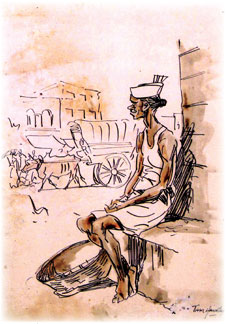Ink and wash in line drawings
by Tissa Hewavitarane
There is a large variety of ink in the market, from sepia to
waterproof coloured ink such as Indian ink and watersolulable ink. They
vary from brand to brand. Some ink, for example, is not colourfast and
some can be diluted with water more easily than others. So it is
worthwhile to try out several kinds before making a final choice.
You can use a wide range of implements such as a brush, or its
handle; a mapping pen or a dip pen, a nail file or a knife, a palette
knife or a match stick to apply ink. With a brush you can create a line
or a wash, whereas most other tools produce only a line.
When starting a drawing try out different kinds of paper because the
surface of the paper directly affects the kind of line you will get. If
you are using watercolour paper especially a rough one, the nib of the
pen will scratch and drag on the paper so that you do not get a fluid
line.
 |
|
A street corner vendor |
A hot-pressed or smooth paper is therefore better with a pen.
However, if you are using a brush you can draw on a rough paper,
dragging the brush across it.
The undulations in the paper will come through in the marks you make,
and give them an interesting look. One should not do anything physically
strenuous before creating an ink drawing because this makes your pen
shake. Some artists always practise their strokes, warming up their
hands before sketching until they get the stokes right. In the same way,
first practise your strokes, because once you have committed a mark on
the paper it is difficult to remove it.
Spontaneity
You can use masking fluid to touch out mistakes, but this tends to
spoil the spontaneity of the medium. To make it easier to avoid mistakes
I sketch a drawing on the paper first. It is possible to add substances
to your ink such as gum arabic which gives it a thickness to your ink
that you can scratch into when it dries. To vary the line, from your
brush or pen over, if you are using a nib you can press on it to open it
out and create a broader line or even paralled lines.
If you use a matchstick you could chew the end and use it to produce
a feathered effect. Pen and ink can be combined with many other media.
You can draw on the surface of your paper with chalk and then draw on
top of it with pen and ink, or you can as turner did, make a pen and ink
drawing and then apply a wash or series of washes over it.
Line and wash with ink has always been a favourite of mine. This
time-proven art form, allows the artist to create bold eye-catching
compositions, rich textures and striking value contacts. The delicate
and bold lines produced by a fine pen nib can produce intricately
detailed work. There is no set up, clean up or extended drying time to
slow you down. So, when doing a drawing with pen and ink learn to
observe, feel free to experiment different techniques in drawing a human
figure, or a landscape. Notice the figure drawing I have done with pen
and ink outline capturing the characteristics of the vendor. He is
seated at the corner of a road way. A light wash of burnsienna is
applied to give the tonal variety of the lines and strokes on the
painting which are compatible with the mood you want to capture is
expressed clearly. Observe the proportions between the elements of the
body and how the principal lines relate to each other. The whole
paintings is done with one colour, with brisk bold strokes in line.
Notice the bullock-cart at far end done only with a thin nib pen.
Rhythm
It gives the movement and rhythm of driving fast. The brush is used
to apply lines in the same way one forms lines with a pen. A figure
sketch is more dramatic than a still life. It brings into play a higher
number of more complicated recourses both for shade and colour.
There are various techniques and a variety of line drawings available
to draw. For example, contour lines are marks that precisely follow the
curves and planes of an object. Parallel lines are straight marks that
extend in the same direction. Parallel lines provide a flat, smooth
appearance that works well in depicting distant or hazy subjects. A
scribble line is a free flowing mark that loops and twists in a sketchy
manner.
Value is the degree of lightness or darkness present. When ink marks
are arranged closer together or layered one set over another, the value
of the pen-and ink work becomes evident.
Contrast between dark and light value areas and skilful use of
highlights and shadows will add definition and dimension to your work. |

